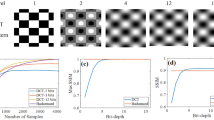Abstract
In order to achieve better image compression simultaneously maintaining the high signal quality, the image sampling has become very important. Also, since the human eye sensitivity has circularly symmetric distribution, in recent years it is usual to apply log-polar image sampling. In this paper, we perform optimization of log-polar image sampling and show the significant improvement in comparison with the product log-polar sampling. Namely, for equal numbers of sensors optimal model gives higher signal-to-noise ratio (SNR) up to 2.5 dB, i.e., it is possible to decrease the number of required sensors by 45% for the same SNR. Furthermore, research shows that in optimal log-polar image sampling, the middle region of image, which is not sampled, can be made to be smaller than in the case of product sampling.
Similar content being viewed by others
References
Digital Video Image Quality and Perceptual Coding, Eds. H. R. Wu, K. R. Rao, in Marcel Dekker Series in Signal Processing and Communications (CRC Press Taylor & Francis Group, London, 2005).
A. Shortt, T. Naughton, and B. Javidi, IEEE Trans. Image Process. 16, 1548 (2007).
S. Liu and A. C. Bovik, J. Visual Commun. Image Represent. 16, 643 (2005).
P. F, Swaszek, IEEE Trans. Commun. 33, 518 (1985).
P. W. Moo and D. L. Neuhoff, in Proc. 1998 IEEE Int. Symp. Information Theory (ISIT’98), Cambridge, USA, Aug. 16–21, 1998 (IEEE, New York, 1998), p. 100.
Z. Perić and M. Stefanović, AEU-Int. J. Electronics and Commun. 56, 345 (2002).
A. Shortt, T. Naughton, and B. Javidi, Opt. Express 14, 5129 (2006).
G. Metta, A. Gasteratos, and G. Sandini, Mechatronics 14, 989 (2004).
J. Boluda and F. Pardo, Electronic Imaging 14(1), 1 (2004).
H. M. Gomes and R. B. Fisher, in Proc. 19th Brazilian Symp. on Computer Graphics and Image Processing, Florianopolis, Oct. 16–18, 2001 (State Univ. Campinas, San Paulo, 2001), p. 338.
A. Yeung and N. Barnes, Int. J. Intell. Syst. Technol. Appl. (IJISTA) 1(1/2), 157 (2005).
E. Candes and J. Romberg, Inverse Probl. 23, 969 (2007).
Z. Kh. Perich, A. Z. Iovanovich, M. Ch. Stufanovich, and S. M. Bogosavl’evich, Radiotekh. Elektron. (Moscow) 52, 1446 (2007) [J. Commun. Technol. Electron. 52, 1340 (2007)].
N. Jayant and P. Noll, Digital Coding Of Waveforms: Principles and Applications to Speech and Video (Prentice-Hall, Upper Saddle River, 1984).
A. Gersho and R. M. Gray, Vector Quantization and Signal Compression (Kluwer Academic Publishing, Amsterdam, 1992).
Author information
Authors and Affiliations
Additional information
Published in Russian in Radiotekhnika i Elektronika, 2009, Vol. 54, No. 12, pp. 1474–1480.
The article was translated by the authors.
Rights and permissions
About this article
Cite this article
Perić, Z., Dinčić, M. & Jovanović, A. Optimal log-polar image sampling. J. Commun. Technol. Electron. 54, 1397–1402 (2009). https://doi.org/10.1134/S1064226909120092
Received:
Published:
Issue Date:
DOI: https://doi.org/10.1134/S1064226909120092




